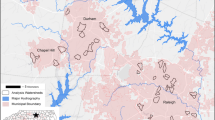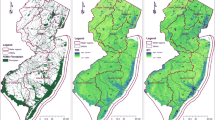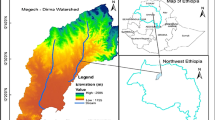Abstract
Elevated nitrate concentrations in streamwater are a major environmental management problem. While land use exerts a large control on stream nitrate, hydrology often plays an equally important role. To date, predictions of low-flow nitrate in ungauged watersheds have been poor because of the difficulty in describing the uniqueness of watershed hydrology over large areas. Clearly, hydrologic response varies depending on the states and stocks of water, flow pathways, and residence times. How to capture the dominant hydrological controls that combine with land use to define streamwater nitrate concentration is a major research challenge. This paper tests the new Hydrologic Landscape Regions (HLRs) watershed classification scheme of Wolock and others (Environmental Management 34:S71-S88, 2004) to address the question: Can HLRs be used as a way to predict low-flow nitrate? We also test a number of other indexes including inverse-distance weighting of land use and the well-known topographic index (TI) to address the question: How do other terrain and land use measures compare to HLR in terms of their ability to predict low-flow nitrate concentration? We test this for 76 watersheds in western Oregon using the U.S. Environmental Protection Agency’s Environmental Monitoring and Assessment Program and Regional Environmental Monitoring and Assessment Program data. We found that HLRs did not significantly improve nitrate predictions beyond the standard TI and land-use metrics. Using TI and inverse-distance weighting did not improve nitrate predictions; the best models were the percentage land use—elevation models. We did, however, see an improvement of chloride predictions using HLRs, TI, and inverse-distance weighting; adding HLRs and TI significantly improved model predictions and the best models used inverse-distance weighting and elevation. One interesting result of this study is elevation consistently predicted nitrate better than TI or the hydrologic classification scheme.





Similar content being viewed by others
References
Arheimer B, Liden R (2000) Nitrogen and phosphorous concentrations from agricultural catchments—influence of spatial and temporal variables. Journal of Hydrology 227:140–159
Baker JP, Landers DH, Lee H, Ringold PL, Sumner RR, Wigington PJ, Bennett RS, Preston EM, Frick WE, Sigleo AC, Specht DT, Young DR (1995) Ecosystem management research in the Pacific Northwest: five-year research strategy. EPA/600/R-95/069. U.S. EPA, Corvallis, OR
Baker ME, Wiley MJ, Seelbach PW (2001) GIS-based hydrologic modeling of riparian areas: implications for stream water quality. Journal of the American Water Resources Association 37:1615–1627
Beven KJ (2000) Uniqueness of place and process representations in hydrological modeling. Hydrology and Earth System Sciences 4:203–213
Beven KJ, Kirkby MJ (1979) A physically based, variable contributing area model of basin hydrology. Hydrological Sciences 24:43–69
Burnham KP, Anderson DR (1998) Model selection and inference a practical information-theoretic approach. Springer-Verlag, New York
Chapman T (1987) Classification of regions. In: Falkenmark M, Chapman T (eds) Comparative hydrology: an ecological approach to land and water resources. Unesco, Stockholm, pp 50–74
Christensen S, Simkins S, Teidje JM (1990) Spatial variation of denitrification: dependency of activity centers on the soil environment. Soil Science Society of American Journal 54:1608–1613
Creed IF, Band LE (1998) Export of nitrogen from catchments within a temperate forest: evidence for a unifying mechanism regulated by variable source area dynamics. Water Resources Research 11:3105–3120
Dahm CN, Grimm NB, Marmonier P, Valett HM, Vervier P (1998) Nutrient dynamics at the interface between surface waters and groundwaters. Freshwater Biology 40:427–451
Heisig PM (2000) Effects of residential and agricultural landuses on the chemical quality of baseflow of small streams in the Croton Watershed, southeastern New York. U.S. Geological Survey Water-Resources Investigations Report 99–4173
Herlihy A, Kaufmann P, Reynolds L, Li J, Robison G (1997) Developing indicators of ecological condition in the Willamette Basin: and overview of the Oregon prepilot study for EPA’s EMAP program. In: Laenen A, Dunnette DA (eds) River quality dynamics and restoration. Lewis, CRC Press, Boca Raton, FL, pp 275–282
Herlihy AT, Stoddard JL, Johnson CB (1998) The relationship between stream chemistry and watershed land cover data in the Mid-Atlantic Region. U.S. Water, Airand Soil Pollution 105:377–386
Hill AR, Devito KJ, Campagnolo S, Sanmugades K (2000) Subsurface denitrification in a forest riparian zone: interactions between hydrology and supplies of nitrate and organic carbon. Biogeochemistry 51:193–223
Hjerdt KN, McDonnell JJ, Seibert J, Rodhe A (2004) A new topographic index to quantify downslope controls on local drainage. Water Resources Research 40(W05602):1–6
Hornberger GM, Bencala KE, McKnight DE (1994) Hydrological controls on dissolved organic carbon during snowmelt in the Snake River near Montezuma, Colorado. Biogeochemistry 25:147–165
Howarth RW, Boyer EW, Pabich WJ, Galloway JN (2002) Nitrogen use in the United States from 1961–2000 and potential future trends. Ambio 31:88–96
Hulse DW, Gregory SV, Baker JP (2002) Willamette River basin planning atlas: trajectories of environmental and ecological change. Oregon State University Press, Corvallis
Hunsaker CT, Levine DA (1995) Hierarchical approaches to the study of water quality in rivers. Bioscience 45:193–203
Johnson LB, Richards C, Host GE, Arthur JW (1997) Landscape influences on water chemistry in Midwestern stream ecosystems. Freshwater Biology 37:193–208
Jones KB, Neale AC, Nash MS, Van Remortel RD, Wickham JD, Riitters KH, O’Neill RV (2001) Predicting nutrient and sediment loadings to streams from landscape metrics: a multiple watershed study from the United States Mid-Atlantic Region. Landscape Ecology 16:301–312
Jordan TE, Correll DL, Weller DE (1997) Relating nutrient discharges from watersheds to landuse and streamflow variability. Water Resources Research 33:2579–2590
Kehmeier JW (2000) A spatially explicit method for determining the effects of watershed scale landuse on stream conditions. Master’s thesis. Oregon State University
King PB, Beikman HM (1974) Geology of the conterminous United States at 1:2,500,000 scale—a digital representation of the 1974. King PB, Beikman HM Map. U.S. Geological Survey Digital Data Series DDS-11
King RS, Baker ME, Whigham DF, Weller DE, Jordan TE, Kazyak PF, Hurd MK (2005) Spatial considerations for linking watershed land cover to ecological indicators in streams. Ecological Applications 15:137–153
Kirchner JW, Feng X, Neal C (2001) Catchment-scale advection and dispersion as a mechanism for fractal scaling in stream tracer concentrations. Journal of Hydrology 254:82–101
Lowrance R, Todd R, Fail J Jr, Hendrickson O Jr, Leonard R (1984) Riparian forests as nutrient filters in agricultural watersheds. Bioscience 34:374–377
McClain ME, Boyer ME, Dent CL, Gergel SE, Grimm NB, Groffman PM, Hart SC, Harvey JW, Johnston CA, Mayorga E, McDowell WH, Pinay G (2003) Biogeochemical hot spots and hot moments at the interface of terrestrial and aquatic ecosystems. Ecosystems 6:301–312
McDonnell JJ, Woods R (2004) On the need for catchment classification. Journal of Hydrology 299:2–3
McHale MR, McDonnell JJ, Mitchell MJ, Cirmo CP (2002) A field-based study of soil water and groundwater nitrate release in an Andirondack forested watershed. Water Resources Research 38(4):1–17
Moser TJ, Wigington PJ, Schuft MJ, Kaufmann PR, Herlihy AT, Van Sickle J, McAllister LS (1997) The effect of riparian areas on the ecological condition of small, perennial stream in agricultural landscapes of Western Oregon. Research Plan, EPA/600/R-97/074. Environmental Protection Agency
Neal C, Rosier PTW (1990) Chemical studies of chloride and stable oxygen isotopes in two conifer afforested and moorland sites in the British Uplands. Journal of Hydrology 115:269–283
Norton MM, Fisher TR (2000) The effects of forest on stream water quality in two coastal plain watersheds of the Chesapeake Bay. Ecological Engineering 14:337–362
Nyberg L, Rodhe A, Bishop K (1999) Water transit times and flow paths from two line injections of 3H and 36Cl in a microcatchment at Gardsjon, Sweden. Hydrological Processes 13:1557–1575
Oetter DR, Cohen WB, Berterretche M, Maiersperger TK, Kennedy RE (2000) Land cover mapping in an agricultural setting using multiseasonal Thematic Mapper data. Remote Sensing of Environment 76:139–155
Omernik JM, Griffith GE (1991) Ecological regions versus hydrologic units: frameworks for managing water quality. Journal of Soil and Water Conservation 46:334–340
Owens LB, Edwards WM, Keuren RW (1991) Baseflow and stormflow transport of nutrients from mixed agricultural watersheds. Journal of Environmental Quality 20:407–414
Peck DV, Averill DK, Herlihy AT, Hughes RM, Kaufmann PR, Klemm DJ, Lazorchack M, McCormick FH, Peterson SA, Cappaert MR, Magee T, Monaco A (2005a) Environmental monitoring and assessment program—surface waters western pilot study: field operations manual for non-wadeable rivers and streams. EPA 600/R-05/XXX. U.S. Environmental Protection Agency, Washington, DC
Peck DV, Herlihy AT, Hill BH, Hughes RM, Kaufmann PR, Klemm DJ, Lazorchack JM, McCormick SA, Peterson SA, Ringold PL, Magee T, Cappaert MR (2005b) Environmental monitoring and assessment program—surface waters western pilot study: field operations manual for wadeable streams. EPA 600/R-05/XXX. U.S. Environmental Protection Agency. Office of Research and Development, Washington, DC
Peterjohn WT, Correll DL (1984) Nutrient dynamics in an agricultural watershed: observations on the role of a riparian forest. Ecology 65:1466–1475
Petry J, Soulsby C, Malcolm IA, Youngson AF (2002) Hydrological controls on nutrient concentrations and fluxes in agricultural catchments. Science of the Total Environment 294:95–110
Pinay G, Decamps H, Arles C, Lacassin-Seres M (1989) Topographic influence on carbon and nitrogen dynamics in riverine woods. Archive fur Hydrobiologie 114:401–414
Pionke HB, Urban JB (1985) Effect of agricultural landuse on ground-water quality in a small Pennsylvania watershed. Ground Water 23:80–98
Preston SD (2000) Statistical identification of hydrochemical response units for hydrologic monitoring and regressioning in Maryland. USGS Water-Resources Investigations Report 00-4232. U.S. Geological Service
SAS Institute, Inc., (2003) Getting sStarted with SAS. SAS Institute, Inc., Cary, NC
Schilling KE (2002) Chemical transport from paired agricultural and restored prairie watersheds. Journal of Environmental Quality 31:1184–1193
Sebilo M, Billen G, Grably M, Mariott A (2003) Isotopic composition of nitrate-nitrogen as a marker of riparian and benthic denitrification at the scale of the whole Seine River system. Biogeochemistry 63:35–51
Smart RP, Soulsby C, Neal C, Wade A, Cresser MS, Billett MF, Langan SJ, Edwards AC, Jarvie HP, Owen R (1998) Factors regulating the spatial and temporal distribution of solute concentrations in a major river system in NE Scotland. Science of the Total Environment 221:93–110
Smith RA, Schwarz GA, Alexander RB (1997) Regional interpretations of water-quality monitoring data. Water Resources Research 33:2781–2798
Stoddard JL, Peck DV, Olsen AR, Larson DP, Van Sickle J, Hawkins CP, Hughes RM, Whittier TR, Lomnicky G, Herlihy AT, Kaufman PR, Peterson SA, Ringold PL, Paulsen SG, Blair R (2005) Environmental Monitoring and Assessment Program (EMAP): Western streams and rivers statistical summary. EPA 620/R-05/XXX. U.S. Environmental Protection Agency, Washington, DC
Sylvia DM, Fuhrmann JJ, Hartel PG, Zuberer DA (1998) Principles and applications of soil microbiology. Prentice Hall, Upper Saddle River, NJ
Wagener T, Sivapalan M, Troch P, Woods R (2007) Catchment classification and hydrologic similarity. Geography Compass 1:901–931
Wickham JD, O’Neill RV, Riitters KH, Smith ER, Wade TG, Jones KB (2002) Geographic targeting of increases in nutrient export due to future urbanization. Ecological Applications 12:93–106
Winter TS (2001) The concept of hydrologic landscapes. Journal of the American Water Resources Association 37:335–349
Wolock DM, Winter TC, McMahon G (2004) Delineation and evaluation of hydrologic landscape regions in the United States using geographic information system tools and multivariate statistical analyses. Environmental Management 34(Suppl 1):S71–S88
Acknowledgments
We thank Dan Heggem, Jim Wigington, and John Van Sickle of the Environmental Protection Agency for chemistry and GIS data, Dave Wolock of the United States Geological Survey for hydrologic landscape region maps, and Alan Herlihy, Jim Wigington, and Pete Nelson for useful discussions. Many thanks go to John Van Sickle for reviewing an early version of the manuscript and providing valuable editorial advice. This research was funded by the Environmental Protection Agency cooperative program. TU Delft is thanked for their support of J.J.M. during the final writing stages.
Author information
Authors and Affiliations
Corresponding author
Rights and permissions
About this article
Cite this article
Poor, C.J., McDonnell, J.J. & Bolte, J. Testing the Hydrological Landscape Unit Classification System and Other Terrain Analysis Measures for Predicting Low-Flow Nitrate and Chloride in Watersheds. Environmental Management 42, 877–893 (2008). https://doi.org/10.1007/s00267-008-9168-5
Received:
Revised:
Accepted:
Published:
Issue Date:
DOI: https://doi.org/10.1007/s00267-008-9168-5




